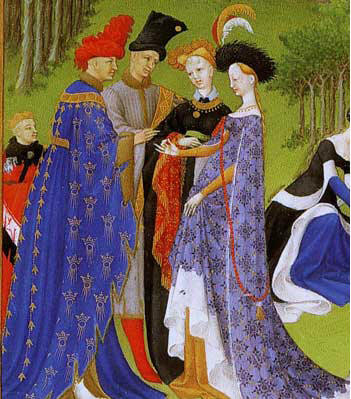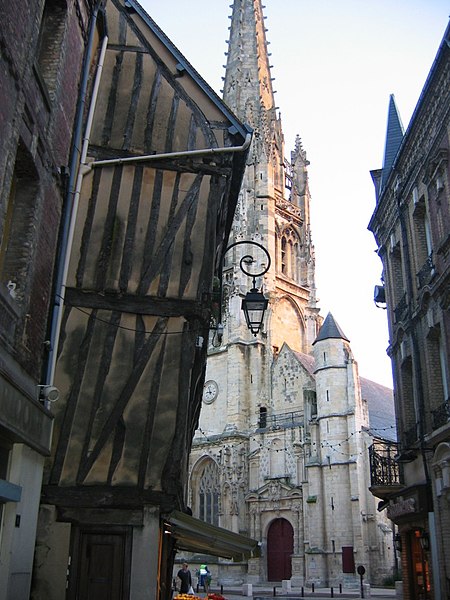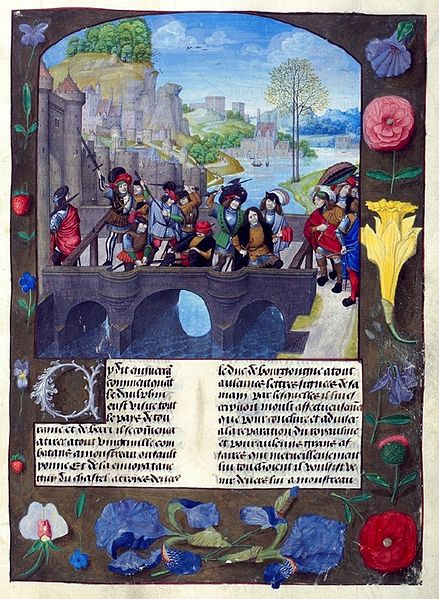 |
| Louis d'Orleans (C) |
On 23rd
November 1402 Jean, the future French
hero of the Hundred Years War, was born at the chateau
at Beauté-sur-Marne[i]. He was the illegitimate son of Louis[ii] Duke of Orléans and his mistress Mariette d’Enghein[iii]. Jean was adopted by
the duke’s wife, Valentina Visconti[iv], daughter of the Duke of Milan.
Jean’s
half-brother Charles, eight years Jean’s senior, was the
heir to the Orléans dukedom. His other half-brothers were Philippe, Count of Vertus born in 1396 and John, Count of Angoulême, born in 1399 his half-sister Margaret was born in 1406. Other children
born to the duke and duchess did not survive childhood.
Valentina
was a cultured lady with some renown as a poetess, her son Charles was to
inherit her talent for poesy. It may be assumed that Jean received the
education fit for the grandson of a king; his flowery and florid signature
betrayed his noble upbringing. His governess was Jeanne de Mesnil.
Louis had been vying with his cousin John the Fearless, Duke of Burgundy, for control lands in the northwest of France. In 1402 Louis, funded by
the French treasury, purchased Luxembourg along with other lands in the region the Duke of Burgundy
thought his own.
Louis was also in conflict with his cousin for control of his
brother Charles VI, King of France, whose descent into
madness was first made apparent in the summer of 1392 when he attacked his
companions, including his brother Louis, in the Fôret de Le Mans, killing one
of his knights and injuring others. Charles’ psychotic periods lasted for
months at a time.
 |
| Funeral of Louis d'Orleans |
Charles’ wife Isabeau was placed at the head of the
Regency council that was the stage for the rivalry between Louis d’Orléans and
John the Fearless. On the day of Jean’s fifth birthday in 1407 Louis d’Orléans
was murdered by order of. John the Fearless[v]
‘[Louis
d’Orléans] accompanied, modestly enough for someone of his rank, by three
mounted men and two on foot, with one or two torches…was struck down and killed
by eight or nine men who had been hidden in a [neighbouring] house….they
cleaved his skull in two with a halberd.’[vi]
John the Fearless promptly took control of the kingdom. Louis’
three sons were at Château-Thierry when they learned of their father’s
death. Allegedly when the three boys were asked by Valentina which of the three
of them would avenge the crime it was Jean who offered to do so At some point
before his death Louis made Jean a knight of the Order of the Porcupine, set up by Louis in 1394.
Civil War
 |
| Marriage of Charles d'Orleans and Bonne d'Armagnac |
Valentina,
Duchess of Orléans outlived her husband by just a year, dying in December 1408.
In August 1410 Charles of Orléans married his second wife Bonne, daughter of Bernard of Armagnac, Constable of France. At the wedding festivities in Gien Charles’ father-in-law took control of what became known as the Armagnac
faction during the Burgundian-Armagnac civil war that arose out of Louis of
Orléans’ assassination. Both sides started bidding for assistance from Henry IV of England.
Bernard
recruited bands of armed men who became known as écorcheurs,
Bernard ravaged the countryside around Paris and even entered the suburbs. A
treaty between the two sides was signed in November 1410 suspended hostilities.
In the
summer of 1411 the three legitimate sons of Louis d’Orléans issued a manifesto
listing the crimes of the Duke of Burgundy and demanding justice for their
father. Addressed to John directly the three brothers proclaimed;
‘We cause you to know that
from this time on we shall harm you with all our power and in all the ways we
can, and we appeal to God and all the prudhommes[vii]
in the world, to come to our aid against you and your disloyal treason.’’[viii]
John the
Fearless sent a mocking reply and emphasised the powerlessness of the Orléans faction
when he entered Paris in October 1411 with an army and
defeated the écorcheurs ensconced
there. The Orléans brothers fled to Bourges, followed by John and his men who laid siege to the town.
John was now
in the driving seat and controlled the French court. In 1412 John the Fearless
made it clear that he was no longer interested in an alliance with the English
by declaring that the king had made him responsible for clearing the English
out of Aquitaine. The Armagnac counter offer was to
help the English retain the county.
 |
| Cabochien revolt |
Charles of
Orléans and his brother John of Angoulême promised to pay homage to Henry for
some of their lands. and handed over the County of Guyenne and recognised Henry V’s suzerainty over Poitou,
Angoulême and Périgord. in return for their support. In return Henry IV was to
provide protection against John the Fearless and provide 1,000 lances and 3,000
archers. John of Angoulême was taken hostage by the English that same year.
The
following year John the Fearless supported the Cabochien Revolt wherein John’s supporters killed many Armagnacs and
innocent bystanders. By the end of the summer of August 1413 Paris was back
under control of the dauphin. John the Fearless, having been outmanoeuvred by
the dauphin[ix], had fled to back to Flanders with the Cabochiens’ leader[x].
Catastrophe
 |
| Harfleur |
On 20th
March 1414 Henry IV died and his heir was the bellicose Henry V who immediately declared his intentions of renewing the
Hundred Years War which had been in abeyance since 1389[xi]. Henry wanted to take
advantage of the strife riving his traditional enemies and collected an army to
invade. In August 1415 laid siege to Harfleur. The capture of the town took longer
than Henry anticipated and it was mid-autumn before his troops were back on the
march.
His troops
met with the French army at Azincourt; during the battle Charles was taken prisoner[xii]. Following his victory
Henry was able to dictate terms to the French and the Treaty of Troyes, signed in May 1420, was the result of his victories
over the demoralised French army. Isabeau signed away her son’s right to the
French throne and gave one of her daughters to the invading king.
Jean fought
with the Armagnacs, during the civil war that ensued
after the death of Louis d’Orléans and he was captured by the Burgundians in 1418 and held prisoner at the old
Chateau
de St-Germain en Laye. At the end of May 1418 Paris was delivered back into
the hands of John the Fearless and his captain Jean de Villiers de l’Isle Adam.
‘Knights, servants and
officers of the duke of Burgundy, accompanied by some 200 men-at-arms, entered
the city of Paris through the Porte St-Germain-de-Prés,
which had been secretly opened for the Lord of l’Isle Adam by a group of nine
or ten common people.’[xiii]
Bernard of
Armagnac and 2,500 of his supporters were massacred when the Burgundian faction
took back Paris, leaving the Armagnacs leaderless.
 |
| Assassination of John the Fearless |
John was
once again master of Paris and he too took to negotiating with the English and
agreeing to their claims to the kingdom. At the same time he began negotiations
with the Dauphin which is how he ended up at the bridge at Montereau the following year.
The assassination of John the Fearless[xiv] on 10th September 1419 in
the presence of the Dauphin only served to heighten the rivalry between the
Burgundians and that Armagnac faction. It decreased the ability of the French
state to oppose the English who continued to steamroller through France. John’s
son Philip now allied with the English,
something John had hesitated to commit himself to.
Jean was released
from Burgundian captivity in 1420 following the intercession of his
half-brother Philippe. Jean entered the service of the Dauphin Charles. The sudden death of Philippe in
September 1420 left Jean the only male representative of the house of Orléans
at liberty and he was henceforth to manage Charles’ inheritance on his behalf.
Bibliography
The Hundred
Years War – Alfred Burne, Folio Society 2005
The Real
Falstaff – Stephen Cooper, Pen and Sword Military 2010
The Reign of
Henry VI – RA Griffiths, Sutton Publishing Ltd 1998
Europe:
Hierarchy and Revolt 1320-1450 – George Holmes, Fontana 1984
The
Fifteenth Century – EF Jacob, Oxford University Press 1997
John the
Fearless – Richard Vaughan, Longmans 1996
Philip the
Good – Richard Vaughan, Boydell Press 2014
www.wikipedia.en
[i]
Throughout his adult life Jean was known as the Bastard of Orléans or by his
title of Count of Dunois.
[iii]
Wife of the lord of Cany who was Chamberlain to King Charles VI of France.
Louis had apparently wanted to marry Mariette but his father had forbidden the
union on political grounds.
[vi]
John the Fearless - Vaughan
[vii]
Those holding to knightly ideals of chivalry
[viii]
John the Fearless - Vaughan
[ix]
The king temporarily regained his sanity during the summer and he was all in
favour of peace, supporting his son in his efforts
[xi]
Despite provocations on both sides. Henry IV had felt constrained by a lack of
money to prosecute a war; his son refused to take this into consideration
[xiii]
John the Fearless - Vaughan
the vagaries of the French would be easier to follow if 50% of them weren't called Jean and most of the rest Louis, Charles or Philippe. The odd Etienne or Gautier or Odie or Geoffroi would be helpful, they were all common names at the time.
ReplyDelete